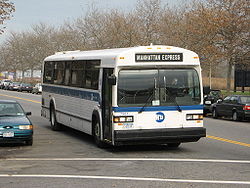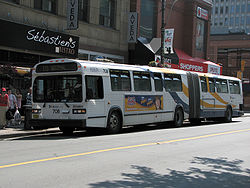- Classic (transit bus)
-
For other uses, see Classic.
Classic (transit bus) 
An MCI Classic TC40-102A configured for commuter service.

An MCI Classic TC60-102N articulated bus operating for Metro Transit of Halifax, Nova Scotia.Manufacturer GM Diesel Division (1982-1987)
Motor Coach Industries (1987-1993)
Nova Bus (1993-1997)Production 1982-1997 Assembly Saint-Eustache, Quebec
Niskayuna, New YorkPredecessor GM New Look Successor Nova Bus LFS Class Transit bus Engine Detroit Diesel 6V71/8V71
Detroit Diesel 6V92/8V92
Cummins C8.3
Detroit Diesel Series 50Transmission Allison, ZF or Voith Length 40 ft (12.19 m)
(16 60 ft (18.29 m) units produced)Width 102 in (2.59 m)  A GM Classic operating in London, Ontario.
A GM Classic operating in London, Ontario.
The Classic is a bus developed by GM from its previous-generation New Look design. The design was originally intended solely for the Canadian market as an alternative to the unpopular RTS but ultimately the Classic, produced from 1982 to 1997, met with widespread success in both Canada and the United States. It was available primarily as a 40 foot (12.2m) long, 102 inch (2.6m) wide coach, although 16 60 foot (18.3 m) long articulated Classics were manufactured. The design was fairly conservative, yet contemporary and less controversial than the RTS.
Contents
History
When GMC in the United States decided to replace the New Look with the RTS II series in 1977, they hoped that they would win over operators in both the US and Canada. But the design and the futuristic look turned off most Canadian transit operators. So in 1979 GM Canada's Transit division decided to continue producing New Looks until 1982, when it unveiled the Classic. Several orders for New Looks were still accepted, built and delivered until 1986 for U.S. properties, although the buses were made in Canada.
The Classic proved to be a hit among not only operators in Canada, but in the United States as well, where the Utah Transit Authority would be the first US transit agency to buy the buses in 1984.
In 1987 GM sold the transit bus division to MCI and TMC. By 1993 the bus division changed hands again, this time going to NovaBus. During the two transitions the Classics continued to be built until NovaBus ceased production on the coaches in 1997, as most agencies were preferring the new low-floor LFS model. The last ever Classics built were in Canada, in 1997, for STO in Gatineau, Quebec.
NovaBus also assembled Classics in the US in 1995 and 1996 from its now-defunct New York state plant. This version is used in Buffalo, Connecticut, Rochester, the suburbs of Chicago (Pace), and Pittsburgh, which was the last US transit agency to acquire Classics. These agencies are slowly retiring the American versions but some have been refurbished and rebuilt by third-party distributors.
NFTA Metro (Buffalo), CT Transit, Metro Transit (Halifax), STO, RTC (Quebec City), Societe Transport de Montreal, and Port Authority of Allegheny County are still running Novabus Classics, however there are fewer and fewer left. It is expected that all but Buffalo's will be retired at the end of December 2011 due to increasing maintenance costs, a lack of parts for the coaches, and the agenices' plans to go to a low-floor bus fleet. Meanwhile, other transit agencies like Regina Transit have begun purchasing used Classics due to rising costs and lack of funding for acquiring newer buses.
Models
The model designations used for Classics consisted of two letters followed by a series of five numbers then another letter. The only versions built were the TC40-102A, TC40-102N and the TC60-102N. All were equipped with an automatic transmission. (Some TC40-102As without center doors have been erroneously identified as SC40-102As, but a true Suburban version would have had a lowered center aisle and underfloor baggage compartments.)
Series Type Length - Width Air conditioning T = transit bus - When first introduced, a suburban (S) version was rumoured to be planned.
A = articulated
C = Classic40 = 40 feet (12 m)
60 = 60 feet (18 m)- Design work was started on a 35-foot (11 m) version, but none were produced.
- 102 = 102 inches (2.6 m) A = air conditioned
N = non-air conditionedThe 60-foot version was not introduced until 1992, after MCI took over production of the Classic design, and only 16 of these articulated buses were ever built (14 for Metro Transit in Halifax, Nova Scotia, and two to Réseau de transport de la Capitale (RTC) in Quebec City, Quebec. NovaBus discontinued the 60-foot articulated version when it took over production from MCI in 1993. This bus is not to be confused with the New Look TA60-102N, a 60-foot articulated version of the New Look manufactured by GMC in 1982, which had the body of a New Look but the front end of a Classic, which allowed for a wider front entrance.
Seating capacity ranged from 39 to 52, and included wheelchair lifts which were optional for Canadian operators but was a requirement for American operators, which had to comply with the Americans with Disabilities Act of 1990.
There were many optional feature in the Classics, among them were the rear exit doors. Most orders were the wide-door versions, but a narrow single-stream door was also available. Another modification during its run was the size of the front destination sign window. A taller and wider version was offered from 1990 as more transit systems specified larger electronic destination signs. (The major exception was Montreal, as MCI and NovaBus built an "M-version"—for Montreal—which retained the narrow destination sign windows, and was ordered primarily by properties in the Montreal area.
In its 15 years of production, a 35-foot long or a 96-inch wide version of the Classic was never made. However, GM, MCI and NovaBus did build a commuter version with all forward-facing seats and without a rear exit.
Currently Dupont Industries, a Quebec City-based company, is refurbishing and rebuilding retired Classics into trolley-like sightseeing buses. Dupont's refurbished Classic is called a Dupont Cartier.
Manufacturers
Company Years built Models GMDD 1982–1987 TC40-102A TC40-102N TA60-102N MCI 1987–1993 TC40-102A TC40-102N TC60-102N NovaBus 1993–1997 TC40-102A TC40-102N TC60-102N Dupont
Industries2007 - Current "Cartier"
(rebuilt GM, MCI and NovaBus Classics)External links
- Photos of Classics from Bus Explorer
- STM Classics
- Rochester, New York Classics
- Port Authority of Allegheny County (Pittsburgh) Novabus Classics
- Yahoo Groups: Classic Bus
North American bus builders Active Eagle Bus
ElDorado National
Federal Coach
Ford Motor Company
Glaval Bus
Gillig Corporation
Girardin Minibus
Goshen CoachPrevost Car
Setra
Stallion Bus Industries
Starcraft Bus
Thomas Built Buses
Trans Tech
Trident Bus IndustriesDefunct ACF-Brill
Aerocoach
AM General
AmTran
Beck
Canadian Car and Foundry
Carpenter Body Company
Corbeil Bus CorporationCrown Coach Corporation
Fageol
Fifth Avenue Bus Company
FitzJohn
Flxible
General Motors Corporation/
General Motors Diesel Division (GM Coach)
KenworthLAG Motorcoach
Mack Trucks
MASA
National Coach Corp.
Neoplan USA
Superior Coach Company
Transportation Manufacturing CorporationTwin Coach
U.S. Bus Corporation
Ward Body Works
Wayne Corporation
Wayne Wheeled Vehicles
White Motor Company
Yellow CoachCategories:- Buses
- General Motors vehicles
- Vehicles introduced in 1982
Wikimedia Foundation. 2010.
